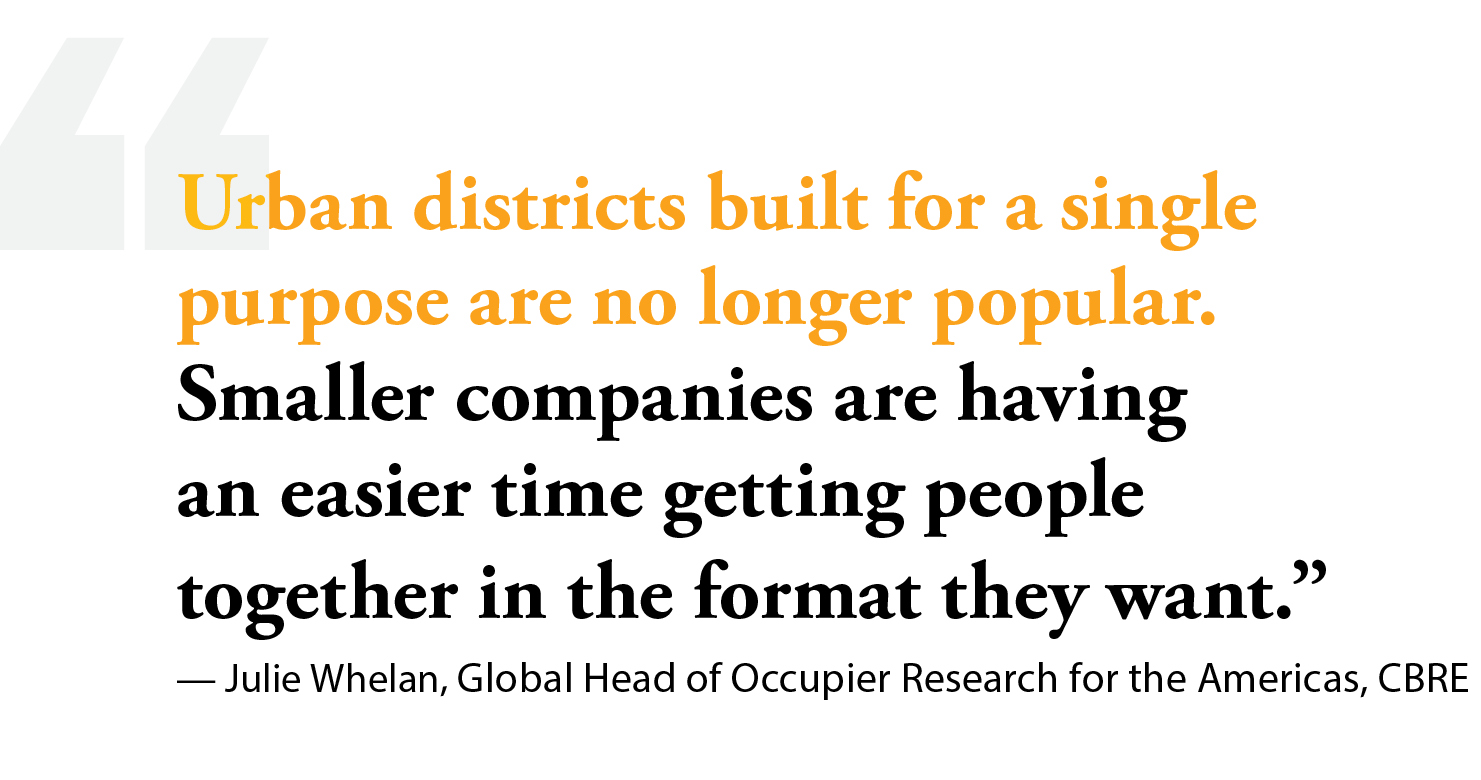Recent data suggest that employers fed up with seeing empty offices have decided to issue mandates. According to JLL and Yahoo Finance, more than a million American workers received a demand to return to the office in the first half of 2023. Another million employees are expected to receive similar mandates in the year’s second half.
These employers are, in essence, giving ultimatums: Either come back to the office to do your job or risk losing it. There’s a better way to solve this dilemma, and it’s one where everybody wins. It’s called site selection. Rather than force people to endure long commutes to work in office spaces they no longer like, why not move those same jobs closer to where people live? The more central business districts in large urban cores empty out, the more attractive it becomes to move the workplace closer to the workers.
Through effective placement of office space, coworking agreements and managed hybrid structures, a growing number of employers are realizing that productivity flourishes when workers are happier and when they like where they work. That’s what’s happening in the northern Atlanta suburb of Alpharetta, which boasts one of the highest amounts of coworking space among all U.S. suburban markets.
Coworking Cafe, a national database that tracks coworking space, recently released a report showing the top U.S. suburbs for coworking centers. The report showed 37 suburbs that have at least 10 flex workspaces, led by Southern California’s Irvine with 91. Other top destinations for coworking places were Newport Beach, California (25), Arlington, Virginia (25), and Oakland, California (24). Also in the top 20 is Alpharetta, Georgia, with 14 centers.
Located in North Fulton County just off Georgia Highway 400, Alpharetta is not only one of the 10 largest employment centers in metro Atlanta; it’s one of its most desirable places to live. A recent ranking by Livability.com showed that Alpharetta neighbor Johns Creek ranked as the No. 1 most livable affordable city in the country.
Companies are following suit. Equifax, Verizon, ADP, UPS, Hi-Rez Studios, Hewlett Packard Enterprise and E-Trade are among the corporate names that have set up shop in Alpharetta. At 25 million sq. ft., Alpharetta offers one of the largest office markets in metro Atlanta.
Perspective from the Mountains
That’s not the only place companies and workers are moving; another is Rabun County in the mountains of northeast Georgia. Robert Pittman, site selection consultant and co-author of “Rebooting Local Economies: How to Build Prosperous Communities,” is a Rabun resident himself. He says that “several small companies have already relocated here, and we think there is room for more. About 20% of the workforce in Rabun County lives in the county but commutes to jobs outside it. A lot of these folks work in skilled industries, and if they had a chance, they would stay inside the county to work for a local employer.”
Examples like this abound in the rural heartland of the country. Places like the Ozarks and the Great Plains are experiencing an immigration of skilled talent that longs for small-town life. The question is: How should employers adapt to these changing demographic patterns?
Since the advent of the global pandemic in March 2020, many employers have struggled with the timing, messaging and policymaking around return-to-office (RTO) plans. In the absence of a one-size-fits-all approach, most have done their best to figure things out as they go along.

 Julie Whelan, global head of occupier research for the Americas for CBRE, says there is a better way. “Urban districts built for a single purpose are no longer popular,” she says. “Smaller companies are having an easier time getting people together in the format they want. When you have smaller groups all in one city, it makes more sense to come together to work.”
Julie Whelan, global head of occupier research for the Americas for CBRE, says there is a better way. “Urban districts built for a single purpose are no longer popular,” she says. “Smaller companies are having an easier time getting people together in the format they want. When you have smaller groups all in one city, it makes more sense to come together to work.”
According to CBRE’s Spring 2023 U.S. Office Occupier Sentiment Survey, almost two-thirds of employers want their employees to return to the office: “65% of respondents say their companies are requiring that employees return to the office. Financial/professional services company respondents lead the trend with 71% reporting that their companies now require a return to the office, most of which are stipulating attendance for more than half the week. On the other hand, only 56% of technology company respondents say their firm requires a return, with most stipulating attendance for less than half the week.”
What we now know, after three years of observation, is that the days of the long commute are over. Every major research study on office workers since 2020 has shown that the commute is the No. 1 roadblock to RTO. That’s why smaller offices located closer to the workforce are thriving while big-city skyscrapers experience record-setting vacancies.
Best U.S. Cities for Remote Workers
Remote workers figured this out before site selectors did. Forbes Advisors studied 11 categories of economic, social and housing data and found that the 10 best metro areas in America for remote workers are:
- Miami-Fort Lauderdale/West Palm Beach, FL
- Indianapolis-Carmel-Anderson, IN
- Omaha-Council Bluffs, NE-IA
- Tulsa, OK
- Detroit-Warren-Dearborn, MI
- San Antonio-New Braunfels, TX
- Jacksonville, FL
- Tampa-St. Petersburg-Clearwater, FL
- Tucson, AZ
- Cleveland-Elyria, OH
According to Forbes Advisors, these markets offer the housing, affordability, schools and amenities people want in a place to live and work. Not surprisingly, many of the places on this list have become magnets for corporate headquarters in the new post-pandemic world.
As reported earlier by Site Selection, a study by The Boyd Company Inc. names the suburbs of Miami, Jacksonville and Tampa as some of the most attractive headquarters locations in the country. The list includes Aventura, Boca Raton, Ponte Vedra, Sunrise and Sarasota.
Not everybody is moving South, however. Midwest markets like Cleveland, Detroit and Indianapolis are all showing big gains in the number of remote workers electing to relocate to these suddenly hot metro areas.
Sarah Iglehart, senior vice president of regional economic development for the Indy Chamber in Indianapolis, says that the factors attracting remote workers to her city “are no different than for any other worker. They are all looking for the same things: unique neighborhoods; an abundance of amenities; good schools for their kids; affordable housing; and a high quality of life. Since we started tracking our net migration numbers on a year-over-year basis, we have seen a significant number of remote workers in the tech and life sciences space evaluating Indy and choosing to move here.”
Another factor draws them, adds Iglehart. “They want options. Workers want to make sure they are not limited in their career and professional opportunities,” she says. “They know that if they come to Indy, they will have their pick of many great jobs.”

